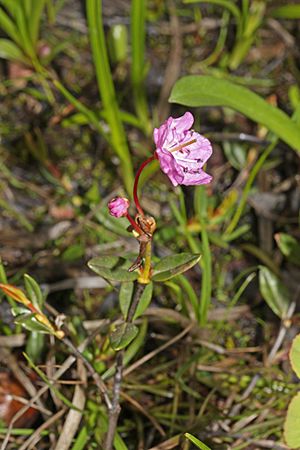Kalmia microphylla facts for kids
Quick facts for kids Kalmia microphylla |
|
|---|---|
 |
|
| Scientific classification | |
| Genus: |
Kalmia
|
| Species: |
microphylla
|
The Kalmia microphylla, also called alpine laurel or bog laurel, is a beautiful plant. It belongs to the Kalmia family, which is known for its pretty flowers. This plant grows naturally in North America. You can find it across the western United States and in western and central Canada.
Contents
Where Does the Name Come From?
The name Kalmia honors a botanist named Pehr Kalm. He was a Swedish-Finnish scientist who studied plants. The second part of the name, microphylla, comes from ancient Greek words. It means "small leaves," which describes this plant well!
What Does it Look Like?
The Kalmia microphylla is a small shrub. It usually grows to about 24 inches tall. Sometimes, it can reach up to 6 feet in height.
Flowers and Fruits
This plant has pretty pink or purple flowers. They are shaped like bells and grow in clusters. Each flower has five petals that are joined together. They open up to form a cup shape. Inside the flowers, there are parts called stamens. When an insect lands on them, the stamens move. This helps to cover the insect with pollen.
After the flowers, the plant grows small, hard, green fruits. These fruits are shaped like capsules with five sections.
Leaves and Branches
The leaves of the Kalmia microphylla are dark green. They are tough and feel a bit like leather. Their edges are often rolled inwards. The leaves grow in pairs on opposite sides of the stem. They stay on the plant all year round.
When the branches are young, they feel fuzzy. As they get older, they become smooth. Their color changes from reddish-brown to grayish.
Where Does it Grow?
The Kalmia microphylla is a perennial plant. This means it lives for more than two years. It grows actively during the spring and summer months.
You can often find this plant in wet places. It likes alpine meadows, open wet areas, and bogs. It grows best in open, moist soil. The soil needs to have very little calcium carbonate. This plant does not like alkaline conditions. You can find Kalmia microphylla from Alaska all the way to California. It has also spread across much of northern Canada.
Important Things to Know
The Kalmia plants are known to be poisonous. They contain a substance called grayanotoxin. It's important not to eat any part of this plant.
However, Kalmia microphylla has also been used for helpful purposes. Some people traditionally used it to make washes for skin problems. They would boil the leaves to create a liquid. This liquid was then used on open sores.
Gallery






